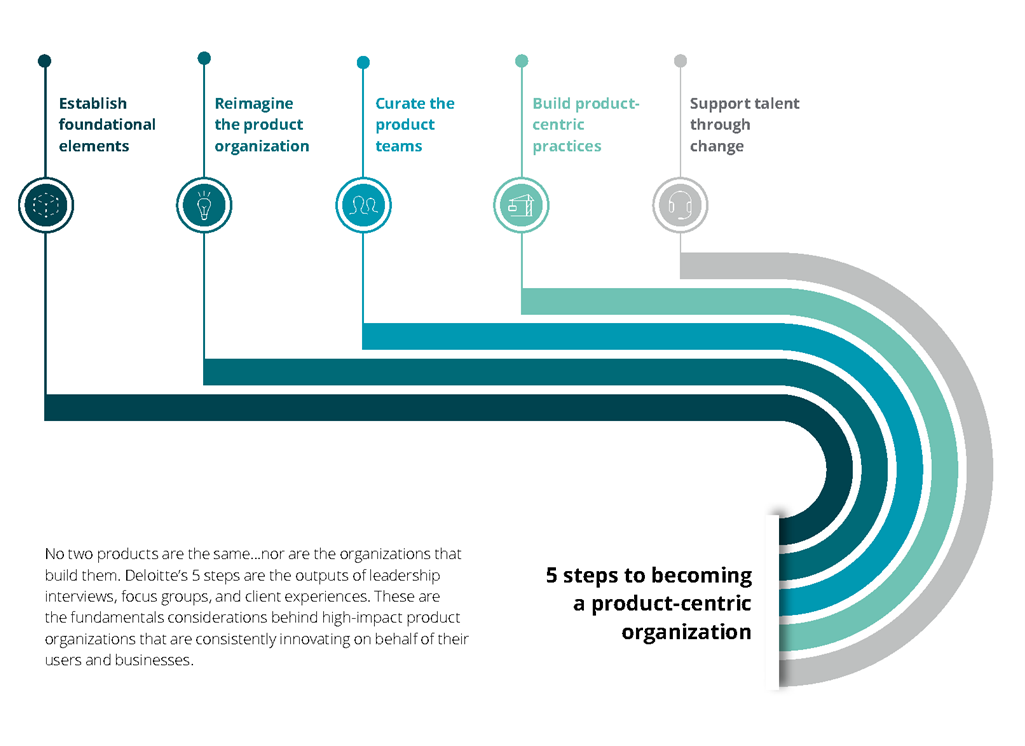5 Steps to Becoming a Product-centric Organization | Deloitte US has been saved
Authored by Anthony Jardim, Tim Juravich, Nate Paynter and Allison Fox
The fast pace of technological advances has led to an increasingly competitive and complex digital landscape. Many successful businesses are leveraging the continuous, data-driven insights of these advances to deliver more value to customers. They’re building highly effective organizations via a product-centric approach.
Find success on your digital journey
More Fortune 500 companies than ever are adopting a digital-first strategy for both enabling revenue generation and increasing cost effectiveness.
Businesses that find the most success on their digital journey drive value frequently and directly to their customers by often leveraging continuous data-driven insights. These companies are building product organizations around a product-centric approach.
Leaders are discovering that creating a product-centric organization often requires rethinking legacy operating models, organizational design, and ways of working. Legacy programs and project-centered operating models often have teams that are siloed by function and have misaligned goal prioritization. These programs also tend to lack the customer focus, agility, and ownership afforded by product-centric operating models. Product organization looks at new ways of cross-functional work, unifying teams around customer-focused outcomes and focusing on decreased time to market.
These are the five considerations to think through as you embark on establishing your own product organization.

Download the PDF to learn more.
1. Establish foundational elements
The first key to establishing a successful product organization is adopting a product-centric mindset, which leverages an approach to developing goods, services, or experiences that emphasize delighting the customer or end user while maximizing value to the enterprise. This marks a major shift in how companies operate internally, cater to customers, and attract top talent.
Organizations interested in adopting a product-centric mindset often encounter early roadblocks by failing to define foundational elements—such as misaligning business strategy, struggling to decouple from legacy project management operating models, and measuring outcomes versus milestones.
2. Reimagine the product organization
Leaders are attracted to the customer focus, agility, accountability, and transparency that product organization promises but can miss out on these benefits without rethinking how they’re structured, how ownership is split between teams, and how people work together. To reap the rewards of product organization, companies need to put in place a clear reporting structure, crisply define ownership between cross-functional teams, and establish ways of working to promote teaming. We recommend companies prioritize thinking about what kinds of organizational and operational changes they need to make on the journey to reimagine product organization.
3. Curate the product teams
The most effective product teams are cross-functional by design and may be composed of a product manager, business representative, engineer, and designer. While the methods and tools of communication may vary; however, it is critical to establish clear responsibilities for each of the product team roles to optimize coordinated efforts and handoffs.
Without clearly establishing the responsibilities of each role, the organization risks duplication of work, breakdown in communication between teams, lack of autonomy across product groups, and an ambiguous accountability structure.
4. Build product-centric practices
The most effective product organizations establish ways of working and strive for consistency. Leaders should introduce a product delivery playbook, consolidate the tool stack, and codify procedures for road map prioritization and budget requests to ensure consistency across the organization. Many will quickly find, however, that attempting to establish consistent governance structure, reduce friction across teams with competing priorities, and change the culture to embrace an iterative, agile product-centric mindset is extremely difficult.
5. Support talent through change
Once a company has defined the business case strategy, established the product organization, and organized the operating model around processes that impactfully build product-centric capabilities, it needs to look at how it supports employees. Product management is in demand, and organizations are constantly being challenged with retaining and attracting top talent.
Within Deloitte’s center of excellence, we help companies define and communicate the product management career path and growth opportunities for their employees. A successful product organization will create a culture that focuses on empowering the individual by offering opportunities for leveling up skillsets, advancement, and career growth. We recommend focusing on these three levers to support your talent through the change:
What will you build?
Product leaders must invest the time and effort required to ensure fundamentals of product management are in place for products to be successful. Deloitte’s 5 Steps to Becoming a Product-Centric Organization can be applied to any organization to assess current gaps and identify future areas of improvement. Just as building a product is an iterative process, so is becoming a product-centric organization. Leaders should consistently reevaluate, identify new opportunities, and iterate to enhance the product organization's impact.
Deloitte has worked with product leaders and teams across many industries and at every stage of the maturity scale. Deloitte's Product Management consulting services include diverse offerings such as product leadership services, short-term product bootcamps, product leadership labs, product transformations, and full-stack product teams.
Authors:

